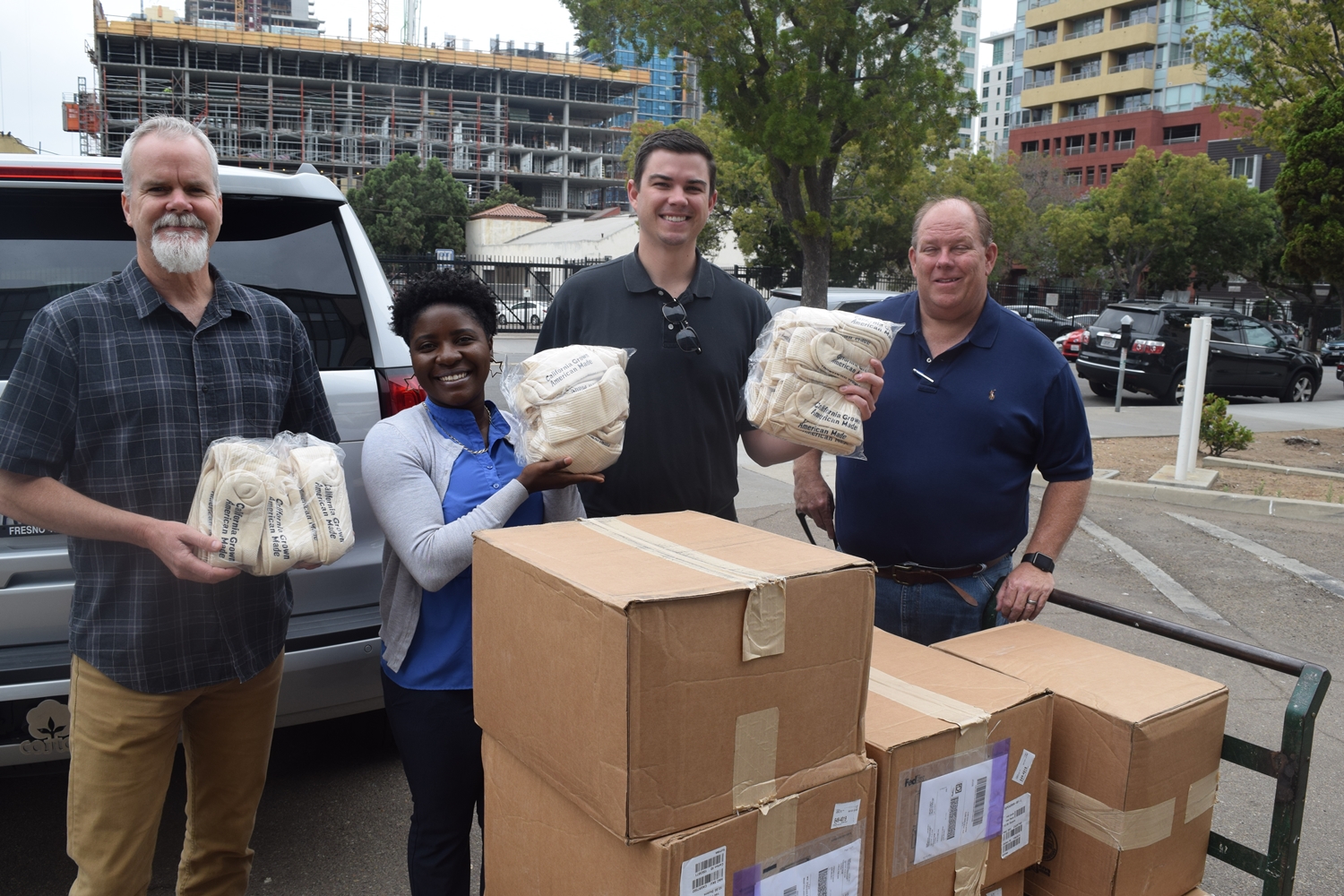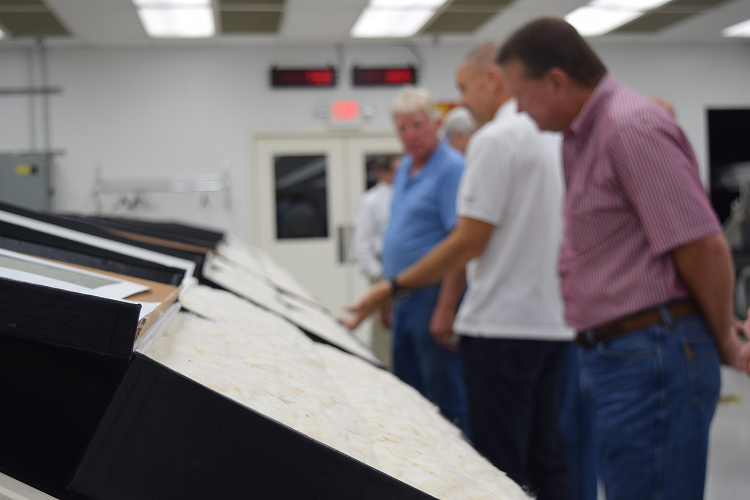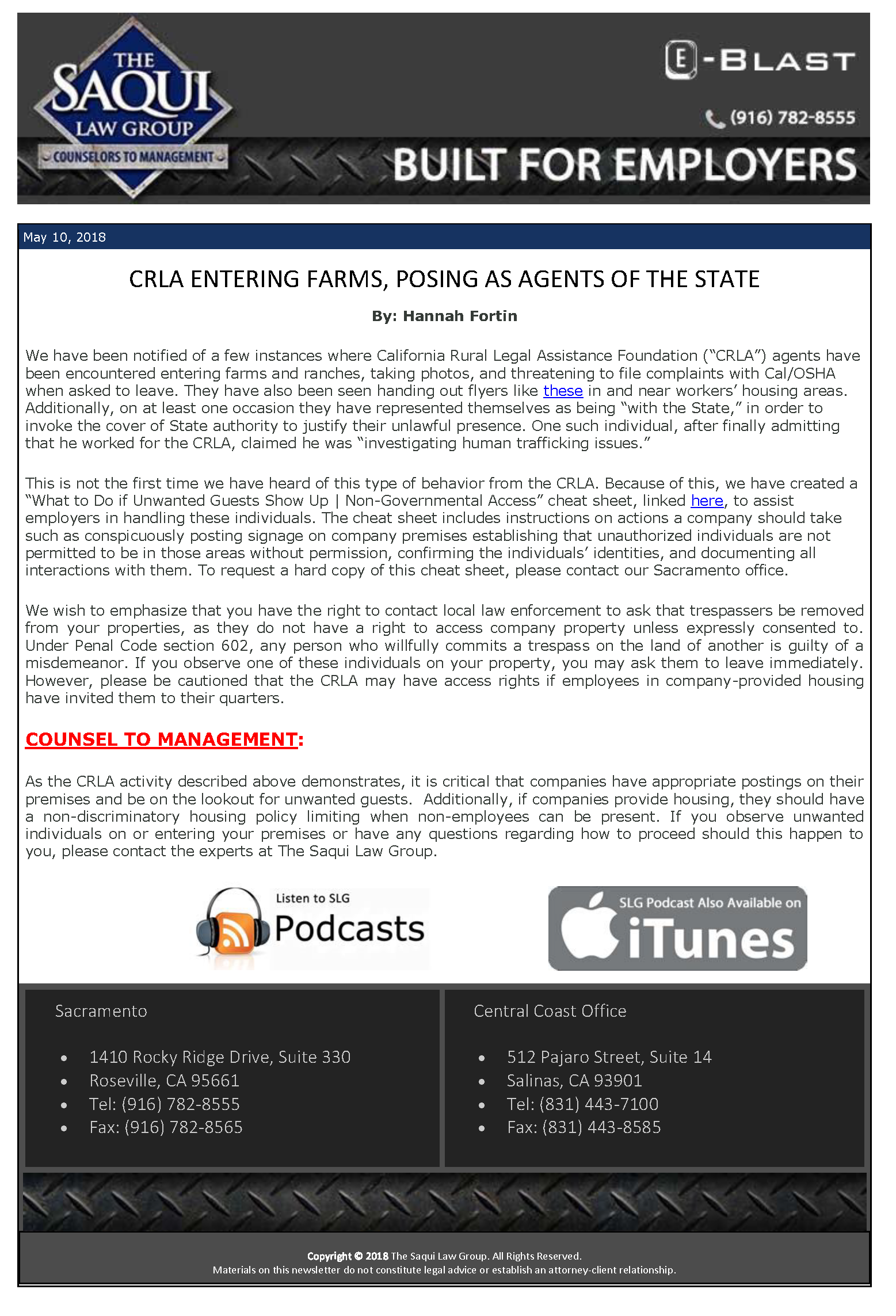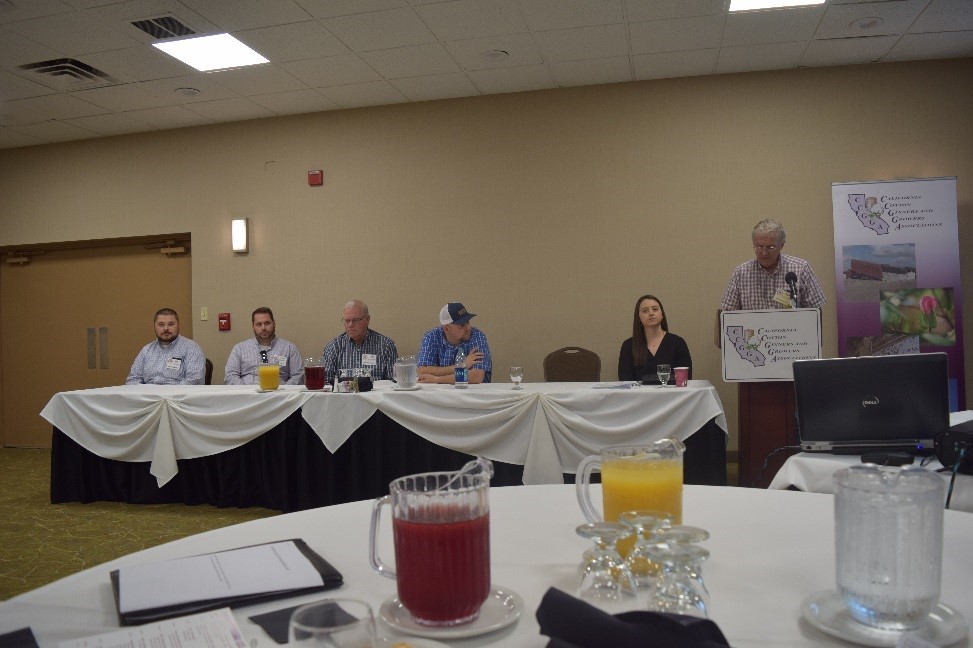The California Cotton Ginners and Growers Association, represented by President/CEO Roger Isom, Chris McGlothlin, Director of Technical Services, and Jodi Raley, Director of Regulatory Affairs, ventured to San Diego to take part in a unique opportunity for the cotton industry to give back to those who have served our country. Senate Pro Tem Toni Atkins represents the 39th Senate District, which includes La Jolla, Del Mar, Downtown San Diego, Point Loma and other surrounding communities. With Point Loma Naval Base and the San Diego Marine Base within her district’s bounds, there is a large population of veterans, some of which who are struggling. CCGGA learned earlier this year that Pro Tem Atkins was passionate about assisting these veterans and hosts on an annual basis a Stand Down event in her district. Stand Down events offer food, shelter, clothing, health screenings and other services to homeless veterans. One of the most requested items for these events is, of all things, socks. Once CCGGA learned of this event and the high demand for good quality socks for these veterans, we started thinking on how we as a fiber industry can contribute to this cause. In partnership with Supima, CCGGA was able to donate 1,000 pairs of California Grown, American Made pima cotton socks. The socks will be distributed at San Diego’s 31st Annual Stand Down taking place June 29th through July 1st. The Association was honored to be able to use our grower’s cotton to be put forward towards a great cause. CCGGA looks forward to continuing this momentum and finding additional opportunities to give back as an industry. CCGGA would like to extend our sincere appreciation and thanks to Supima and Harris & Covington Hosiery Mills for partnering with the Association to make this happen!
NEWS & ISSUES
OSHA Electronic Reporting
As a reminder, all employers – including California – are advised to comply with the directive from federal OSHA to submit their workplace injuries and illnesses electronically. Employers must submit injury and illness data from their 2017 Cal/OSHA Summary 300A form electronically by July 1, 2018. For specific instructions go to federal OSHA’s website https://www.osha.gov/injuryreporting/index.html. Should you have any questions or need assistance, please call our office.

Preliminary Cotton Acreages for California Released
The California Department of Food and Agriculture’s Pink Bollworm Program have released the preliminary acreages for most of the cotton growing counties in California for 2018. The breakdown is as follows:

The grand total of 257,552 acres statewide is down from 295,848 acres statewide in 2017. It is too early for the Pink Bollworm Program to confirm Pima/Upland splits, but current estimates put the split at 82%/18%, but we will wait to confirm what was actually planted.
Save the Date: American Pima Cotton Standards Matching
CRLA Entering Farms, Posing as Agents of the State
Urgent Bulletin
Effective January 1, 2017, employers in states regulated by federal OSHA were required to electronically submit Log 300 records of injuries and illnesses. The electronic reporting requirements, along with the incorporation of an existing statutory prohibition on retaliating against employees for reporting work-related injuries or illnesses, were added to federal OSHA’s recording and reporting regulations found in the Code of Federal Regulations, title 29, part 1904.
On April 30, 2018, federal OSHA posted a “trade release” requiring all affected employers to submit injury and illness data in the federal OSHA Injury Tracking Application (ITA) online portal, even if the employer is covered by a state plan that has not completed adoption of their own state rule.
Therefore, even though California has not yet adopted its own state rule, employers are advised to comply with federal OSHA’s directive to provide Form 300A data covering calendar year 2017. Federal OSHA is requiring affected employers to submit their data by July 1, 2018. For specific instructions, go to federal OSHA’s ITA website.
The Association will provide members with instructions on reporting injury data within the next few days, so please stay tuned.
PG&E Phase Two Agricultural Settlement Filed at CPUC
After almost two years of negotiation, a settlement was filed in the Pacific Gas & Electric (PG&E) Phase Two General Rate Case. PG&E originally asked for an average 5.1 percent increase for agriculture, on top of the Phase One revenue requirement for all customers. At the conclusion of negotiations the Ag Energy Consumers Association (AECA), PG&E and other parties settled on a 0.7 percent increase for agriculture. That will be added to the Phase One increase of 5.5 percent in 2019 and 4.9 percent in 2020.
Also under discussion was a proposed shift in Time-Of-Use (TOU) periods. PG&E proposed to change the peak TOU period from 12:00PM-6:00PM to 5:00PM-10:00PM and eliminate weekend off-peak periods. Peak periods are changing as more solar renewable energy is added to the generation mix. AECA was able secure more reasonable peak period of 5:00PM-8:00PM and ensured that the TOU period shift will not occur until March of 2021. Starting in 2021, weekends will have on-peak periods for the first time, but a new rate was created for those who need a prolonged off-peak period for irrigation. The new rates will be made available to customers to transfer to on an optional basis starting no later than March of 2020. At that time, customers will also be able to use PG&E’s online tool to see how their bills might change under different scenarios. Account and customer service representatives will also be available to help ag customers understand how the changes will impact their bills and to offer best rate options.
Customers who have installed solar will be grandfathered on existing TOU periods for ten years after their interconnection date. PG&E had proposed to narrow the differentials between peak and off-peak prices for solar customers, but AECA was able to work out a timeline for those differentials to be narrowed, to ensure investments made to feed energy back into the grid during peak hours will be protected.
It is important to note that this settlement has not yet been approved by the CPUC. It is hard to predict when it will be set for a vote, but it is expected to be approved by the end of 2018. AECA is an organization made up of growers, ag associations, water agencies and irrigation districts, ranchers and food processors. Association President/CEO Roger Isom is the current President of AECA.
California Cotton Acreage is Down Due to Lack of Water
In December, growers indicated California would see an increase in cotton acreage for the third year in a row. But then it didn’t rain until March. And then when it rained, the water allocations didn’t match expectations. As a result, California is preliminarily expecting about at 15% decrease in overall cotton acreage for 2018.
According to preliminary planting intentions survey conducted by the California Cotton Ginners and Growers Association this past month, the Association is currently estimating approximately 205,000 acres of pima and 43,000 acres of upland statewide for the 2018 cotton season plus or minus 10%. This survey is based on surveys from all of the gins in California prior to planting and a lot can happen between now and when things are actually planted. If it plays out, it will represent a 2% decrease in pima acreage and a 50% decrease in upland acreage in California as compared to 2017. Again, this is very preliminary, but reflects what all gins are reporting.
Association Continues Effort to Prevent Sticky Cotton
This past week, the California Cotton Ginners and Growers Association held its 2018 Sticky Cotton Summit bringing merchants, growers, gin managers, researchers, and PCAs together to discuss this critical issue in Fresno. Giving the merchant perspective were Earl Williams, Supima, and Leigh Pell, Allenberg. Providing an update on the research into the measurement of stickiness was Derek Whitelock, USDA ARS SWCGRL and Chris Delhom, USDA ARS SRRC. Another aspect that was discussed is what cotton gins are doing to deter sticky cotton and providing their insight on what their gins are doing were Wayne Gilbert, County Line Gin; Adriane Carbonel, Farmers Cooperative Gin; and Stan Creelman, Mid Valley Cotton Growers. The California Department of Food and Agriculture presented an overview of the monitoring and mapping efforts in 2017 for aphids, which was presented by Lauren Murphy, CDFA Pink Bollworm Program. Greg Palla, with San Joaquin Valley Quality Cotton Growers made a presentation on a Cotton Clean technology, a bacterial enzyme that works to break down the sugar. A key element to the program was what growers and PCAs are doing to combat whitefly and aphids in the field and providing their thoughts were Bob Hutmacher, UCCE, Tim DeSilva, J.G. Boswell Company, Bryce Borges, Crop Production Services, Andy Gulley, Simplot, and Nick Groenenberg.
Action items coming out of the meeting included the following:
- Continue and increase cotton stickiness testing efforts with USDA
- Provide additional samples of sticky seed cotton to USDA for research purposes
- Include details of difficulty ginning, etc.
- Use samples from small plot field trials from UCCE (B. Hutmacher/T. Pierce)
- Continue research with Cotton Clean technology
- Continue aphid and whitefly monitoring with CDFA, but increase frequency of reporting
- Look into AgLogic production/distribution of aldicarb into California
- Work to expand Movento label for whitefly
- Support bindweed management research
CARB Lawsuit Rolls Back Ag Provisions
The Truck and Bus Regulation will be making significant changes once again after the 5th Circuit Court of Appeals ruled in favor of the plaintiff regarding agricultural provisions added during 2014. The plaintiff (John R. Lawson Rock and Oil of Fresno, partnering with the California Trucking Association), sued CARB in Fresno County Superior Court claiming that the amendments to the Truck and Bus Regulation were unfair to other industries based off of extended timelines for compliance and an increased allowance in mileage for agricultural fleets. The Superior Court ruled in favor of the plaintiffs and CARB quickly filed an appeal with the 5th Circuit. In January, the Superior Court also ruled in favor of the plaintiff, removing the 2014 amendments.
This week, letters are being sent to Truck and Bus Stakeholders throughout the state regarding the changes that will take place once the court’s decision becomes effective. Changes to the rule include:
- Low Use Exemption: Less than 1000 miles allowed in California per year only.
- Agricultural Vehicle Mileage Requirements: Starting January 1, 2011, vehicles that operated less than 10,000 miles per year can continue to use the extension until January 1, 2023.
While the letters are not specific on the date in which the court decision goes into effect, it should be noted that the letter indicates that non-compliance during this next year of reporting will result in required replacement, repower or retrofit of the vehicles compliant with the Engine Model Year schedule of the regulations.This is crucial, if you claimed the Low-Use Exemption, then you must keep your vehicle below the 1,000 mile limitation.Ag Mileage Exemption limitations are now rolled back to 10,000 miles.If you have any questions, please feel free to contact us here at the office.



